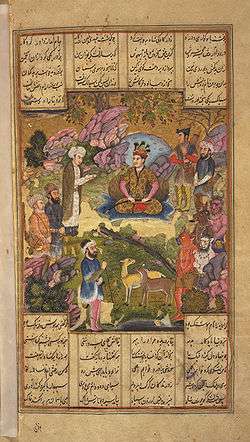Keyumars

Keyumars (Persian: کیومرث) is the Persian form of the name Gayō Marətan (appearing in medieval Zoroastrian texts as Gayōmard or Gayōmart), the Avestan name of the mythological first human being in the world. The corresponding name in Middle Persian is Kayōmart.
In Ferdowsi's Shahnameh he appears as the first shah of the world. He is also called the pishdād (پيشداد), the first to practice justice, the lawgiver.
The Avestan form means "the living mortal", from gaya "life" and marətan "mortal, human being"; cf. Persian mard "human" (Persian: مَرد).
Keyumars is also a popular first name in contemporary Iran.
In Zoroastrian literature
According to the Zoroastrian creation myth, Gayōmart was the first human, or, according to the Avesta, he was the first person to worship Ahura Mazda. The Avestan forms Mashya and Mashyana appear as the male and female first humans; their names are versions of the word marətan "mortal".
In the eighth book of the Denkard, a reference is made to the Chethrdāt section of the Avesta, which is divided into 21 sections. Apparently this section dealt with how the world and mankind were created, including the creation of Gayōmart. References are also made to the Varshtmānsar section, which also included information about Gayōmart which Ahura Mazda had given to Zoroaster: "For 30 centuries I kept the world from corruption and decay, when the 30th century came to an end the Dīvs assaulted Gayōmart ... But I finally repelled them and plunged them into the darkness".
A concise story of Gayōmart according to Middle Persian texts is given by Zabihollah Safa:
Gayōmart Gar-shāh (King of the Mountains) was the first human Uhrmazd created. Before Gayōmart came, in the fifth "Gāh" (Ahura Mazda created the world in six Gāhs) Gavevagdāt was created from mud in Erān-vēdj (which was the middle of the earth) on the right side of the river "Veh-Dāit" ... In the sixth "Gāh" Gayōmart was created from mud ... on the left side of "Veh-Dāit", to help Uhrmazd and he was created as a 15-year-old boy. They lived for 3000 years in peace and they did not pray, did not eat and did not talk but Gayōmart was thinking about this. At the end of the 3000 period, which Ahriman was stunned and could not do anything Jēh yelled which woke him up ... upon this, Ahriman and his minions the Dīvs fought with the light and in the first day of the spring (1st of Farvardin, the Iranian new year) leaped onto the earth as a dragon. He started to create death, illness, lust, thirst, hunger among the life forms and spread evil beings in the world (The 'Kyrm', which includes reptiles, insects and rodents) ... In the catastrophe Gavevagdāt died ( This is also the symbol of the last year giving way to the new year, as depicted in Persepolis reliefs). And Ahriman left "Astovidat" (A Dīv) to guard Gayōmart, but could not kill him because his fate had not yet come ... From that time he lived for 30 years and upon death fell on his left side and his semen fell to the ground which was fertilized by the sun ... and after 40 years there grew Mashya and Mashyana as two rhubarbs ..." [1]
In the Avesta, Gayōmart is named as the pure and righteous, and according to Zoroastrian tradition the genealogy of Zoroaster can be traced through 45 generations to him.
In the Shahnameh
Ferdowsi's great epic poem, the Shahnameh, begins with the story of Keyumars. He was the first king to arise among humans, who at that time lived in mountain caves and wore the skins of leopards. Keyumars was also the first human to introduce royal practices, preparation of food and the first practitioner of law and justice. He was so powerful that all humans, tame animals, and wild animals paid homage to him. God (Ahura Mazda) granted Keyumars the supernatural radiance called the farr (Avestan xvarənah), reserved for kings. His son was Siāmak (سیامک) was beloved of all except the Devil, Ahriman, who raised an army under the command of his own demonic son. When the angel Sorush (Avestan Sraoša) warned Keyumars, Siāmak led an army of his own. Siāmak accepted a challenge to single combat and died at the hands of the demon.
Keyumars mourned for a year, and then Sorush advised him to fight Ahriman once more. Siāmak's son Hushang (Avestan Haošyaŋha) was grown by this time and led the army that defeated Ahriman's son, who was bound and beheaded. Keyumars died after a thirty-year reign, leaving his throne to Hushang.
Sources
- Abolqasem Ferdowsi, Dick Davis trans. (2006), Shahnameh: The Persian Book of Kings ISBN 0-670-03485-1, modern English translation (abridged), current standard
- Warner, Arthur and Edmond Warner, (translators) The Shahnama of Firdausi, 9 vols. (London: Keegan Paul, 1905-1925) (complete English verse translation)
- Shirzad Aghaee, Nam-e kasan va ja'i-ha dar Shahnama-ye Ferdousi (Personalities and Places in the Shahnama of Ferdousi, Nyköping, Sweden, 1993. (ISBN 91-630-1959-0)
- Jalal Khāleghi Motlagh, Editor, The Shahnameh, to be published in 8 volumes (ca. 500 pages each), consisting of six volumes of text and two volumes of explanatory notes. See: Center for Iranian Studies, Columbia University.
References
- ↑ Hamase-sarâ’i dar Iran, Tehran 1945 (2000)
- Shaki, Mansour (2001), "Gayōmard", in Yarshater, E., Encyclopædia Iranica, 10, Routledge & Kegan Paul, ISBN 978-0-933273-56-6
External links
- A king's book of kings: the Shah-nameh of Shah Tahmasp, an exhibition catalog from The Metropolitan Museum of Art (fully available online as PDF), which contains material on Keyumars
| Preceded by none |
Legendary Kings of the Shāhnāmeh 0-30 |
Succeeded by Hushang |


.png)